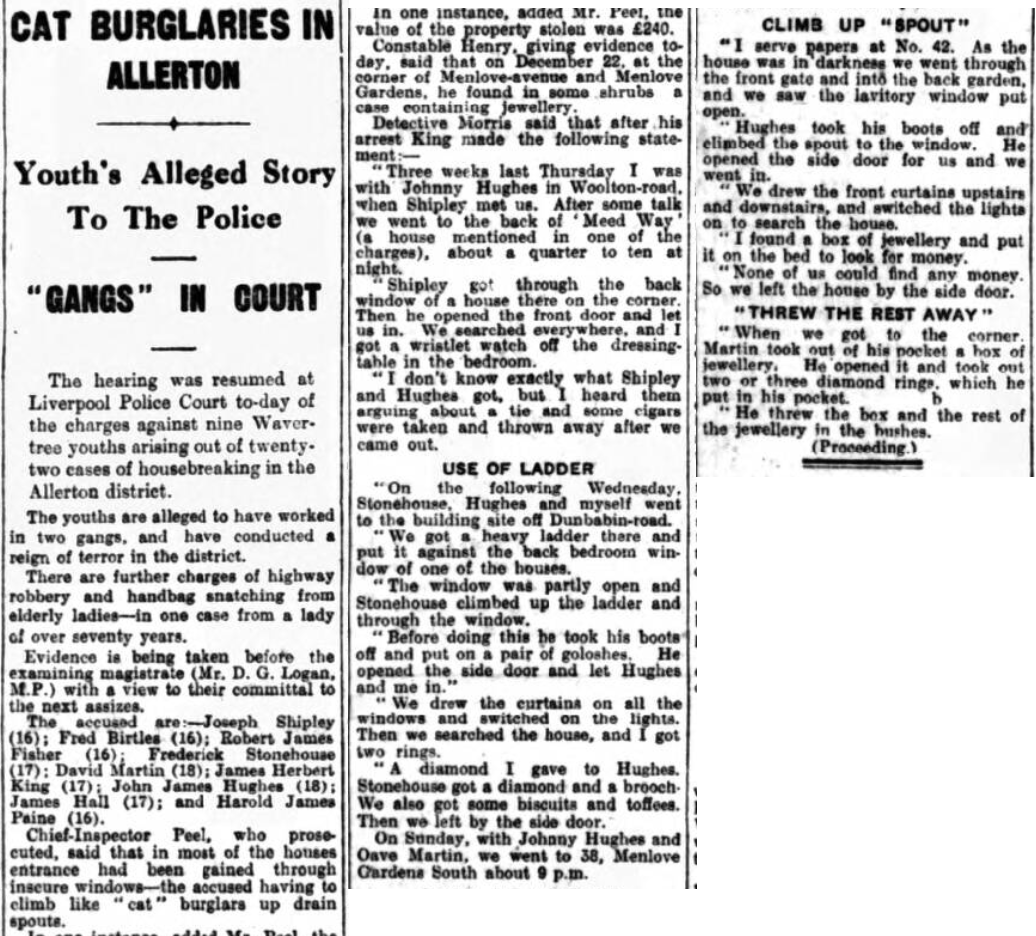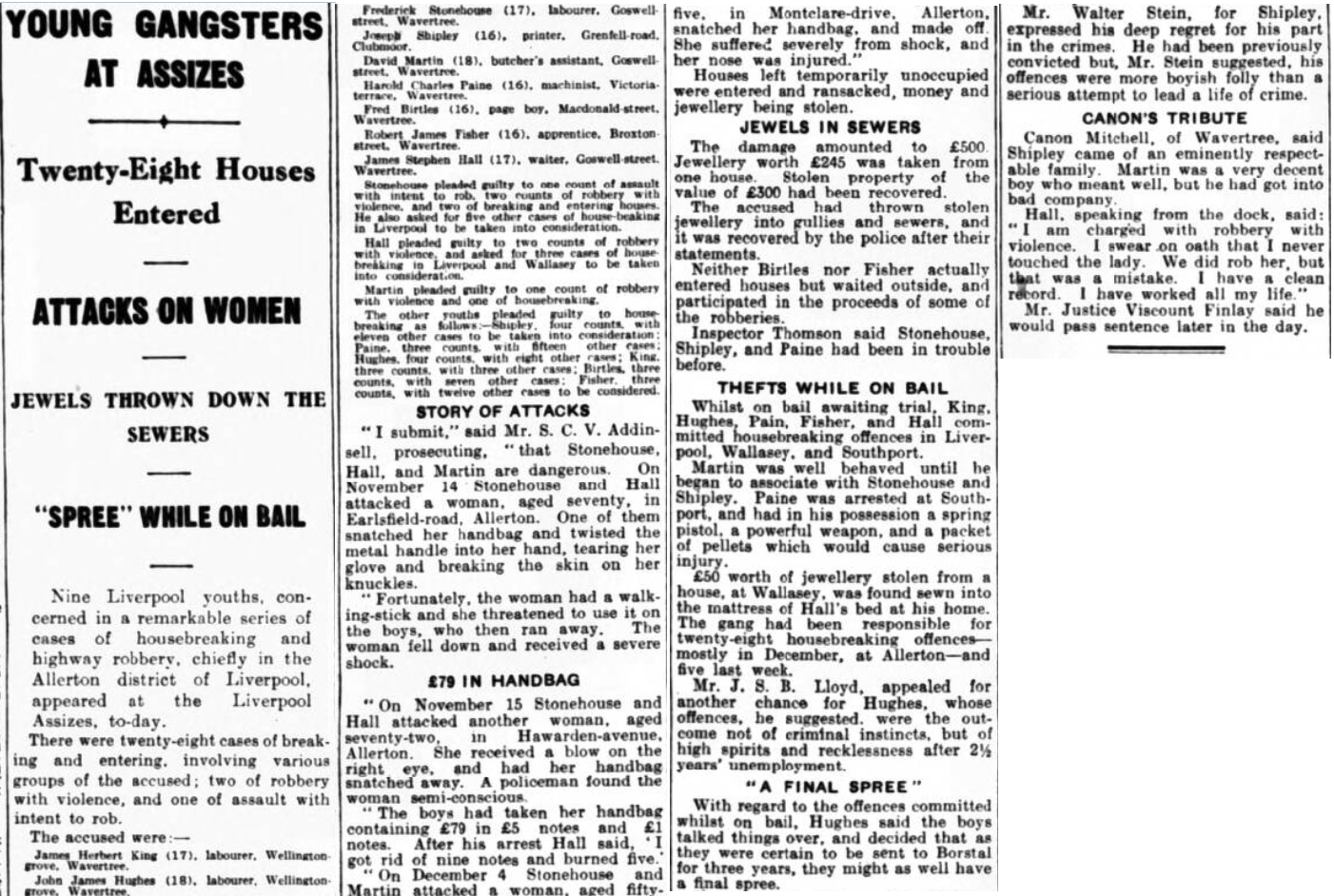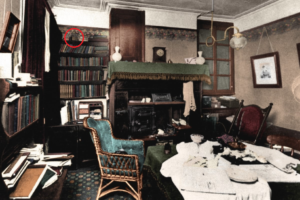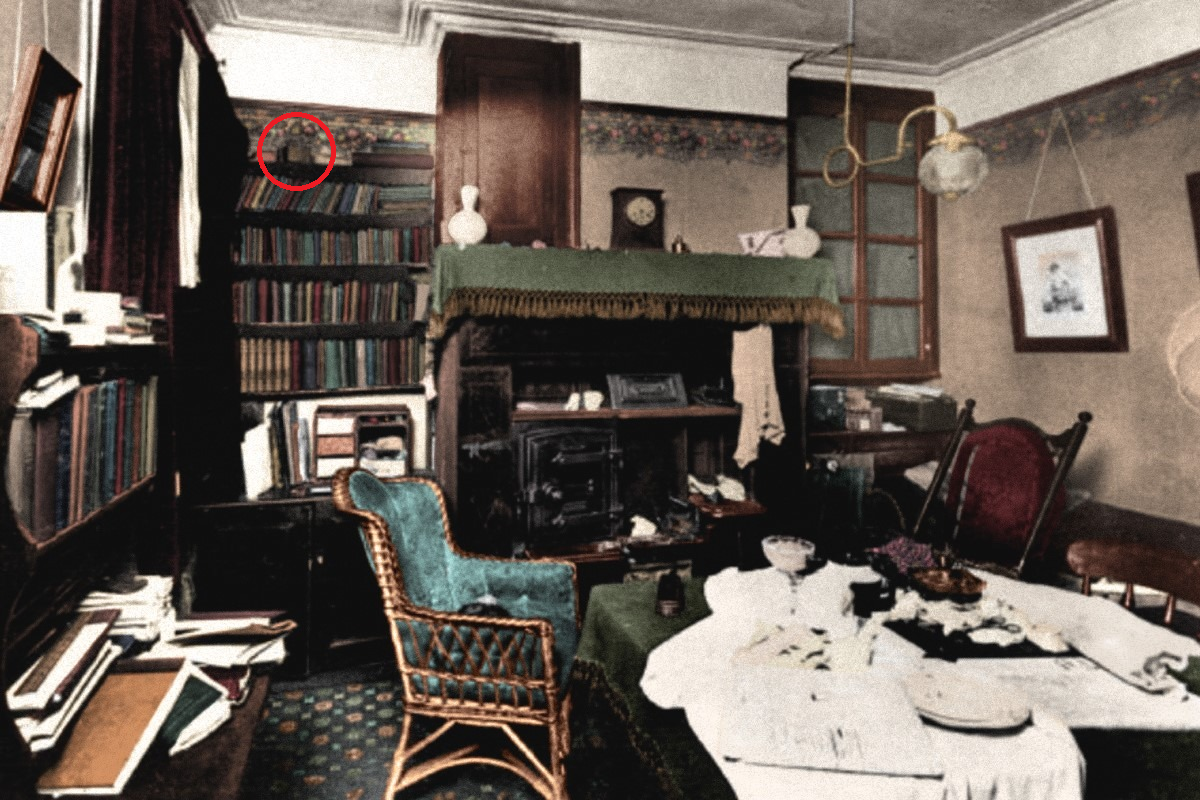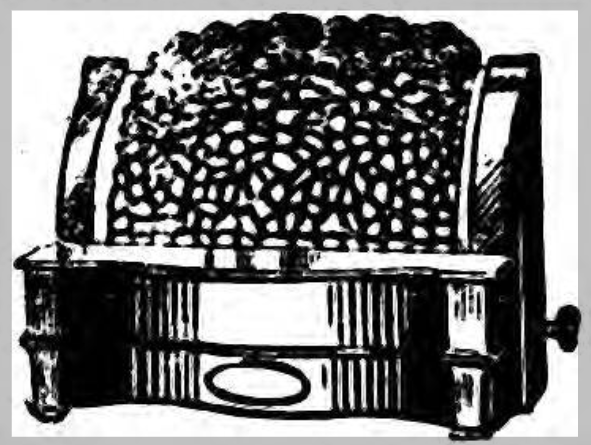Previously I believed that the forerunner theory was the idea of a two-man job at Wolverton Street, in the form of a distraction robbery. There are some things that led me to this, such as the thought of what Julia was doing in the parlour had she just discovered a murderer. But there was also something I felt more important, which was a recent robbery which had taken place at Menlove Gardens South only a month prior.
Given that knowing Menlove Gardens East did not exist would probably require some knowledge of the Gardens themselves (even some residents did not know for sure it did not exist), it seemed suggestive to me.
—
Click the images to view in full size.
—
The above article details a housebreaking that took place at an address in Menlove Gardens on December the 21st (almost one month exactly before Julia was murdered). The police believed this gang to be responsible for around 29 housebreakings in the Allerton area.
Three individuals broke into the home at the same time and later dumped items including jewelry down drainage grids, which is where Parkes would state Parry told him he’d put the iron bar.
Keep in mind that at the same time as this was going on, there was a string of some 20 to 30 break-ins around Anfield where the Wallaces lived, including a burglary on the very same street in December 1930 (19 Wolverton Street) – evidently within days of the Menlove Gardens South break-in. In all of these cases there was no sign of forced entry, leading police to assume a skeleton key had been used.
The 16 year old Joseph Shipley and Harold James Paine appear to be the “ringleaders” of the Allerton housebreaking gang.
Here’s a later newspaper article from the Liverpool Echo dated January the 28th, 1931:
As seen above, these are thugs who readily use excessive violence to get what they want, and have no qualms about battering women of 70+ years of age to near-unconsciousness for a handbag.
More importantly, this issue (dated January the 28th, 1931) claims the men had committed burglaries “last week” while awaiting trial, which means that they were out on the streets when Julia Wallace was murdered. According to one of the youths they decided amongst themselves to go on one last crime spree while awaiting trial, since they knew they’d be sent to Borstal (juvenile detention center) for years anyway.
There are also these two reports of duplicate key break-ins, which was a widespread problem in Liverpool at the time and should be included:
This latter gang had been operating in the St. Helen’s area of Liverpool with 22 skeleton keys in their possession (duplicate keys were suspected in the “Anfield housebreakings”). Again, these burglars were not operating alone, but entering properties with two or more people at the same time.
—
So we have:
- Three members of a gang breaking into and burgling an address on Menlove Gardens South – showing they likely have some familiarity with the streets… This just one month prior to a murder in which the address 25 Menlove Gardens East is used to lure Wallace from his home, and within days of a robbery at 19 Wolverton Street.
- A large string of “skeleton key” robberies (or simply burglaries where entry was not forced) that had been carried out in the Anfield area and Liverpool at large.
- Reports of a gang a year prior in 1930 operating in the St. Helens district, also using a large set of over twenty skeleton keys.
—
Duplicate keys?
Because of the prevalence of duplicate or skeleton key robberies and how easy it appears to have been (even teenagers were able to fashion large sets of skeleton keys using nothing but a file), it is indeed possible that someone had used such a key to enter the house completely unbeknownst to Julia.
But you run into this issue: If there was no guest admitted by Julia, what was she doing in the parlour?
It’s a possibility she had gone in herself to lounge on the armchair or play the piano (Wallace stated his wife would sometimes play the piano while he was away at chess), but the room was really not much used, and on the surface of things it seems she would probably be found in the living kitchen (the 1930s equivalent of a living room) where the cash box was found.
More likely is that she had genuinely admitted or at least expected a guest, and so it’s either a case that she had known this person, or that they had used some sort of ruse to gain access.
Many peculiarities in the case can easily be resolved if there are two people in the home, and so the idea that she had fallen prey to a “distraction robbery” scheme should be considered, which is one of a few ideas I have on the case that I believe is new and so I should dive into it a bit.
In a distraction robbery scenario, one of the men would be a stranger Julia admitted willingly, keeping her distracted in the parlour; the second man could then gain entry either in the door at the back of the house using a duplicate key, or through an unsecured window. Or even simpler, just two strangers entering through the front door claiming to be some sort of authority figure or workmen etc.
Remember, we already know for a fact from newspaper reports around the time that housebreakers were entering homes with two or three people at once, sometimes more. We also know for a fact that these criminals were able to get into homes without any forced entry; one such robbery had taken place just a few doors down from the Wallace’s home the month just gone.
In a scenario like that, it could be argued that whoever was stealing from the cash box was meant to do so stealthily, and sneak out unheard and unseen – but made some sort of noise during the commissioning of the robbery. As an example, a noise caused by falling coins (coins were found on the floor in front of the bookcase/shelves on top of which the cash box was kept), or the cabinet door which had evidently come free and ended up on the floor.In either of these cases, seeing that Julia had noticed the noise, whoever was with her in the parlour could have hit her before she could investigate.
Do we have any witnesses to corroborate an idea like this? Perhaps. Here’s a very rarely seen statement by a woman named Anne Jane Parsons:
“On Tuesday the 20th January 1931. I was walking up Hanwell Street [which opens out onto Richmond Park, the street from which Wolverton Street’s back entries are accessed] about 8 o’clock in the evening; I think it was nearer 8.15. I was going to a meeting. I noticed a man running down Hanwell Street towards Lower Breck Road. He was followed by another man close behind him who was also running. They were running very fast. I cannot say what they were like. I did not take much notice of them. They only aroused my attention from the fact that they were running so fast.”
—
In a distraction robbery I propose it would go something like this: A man known to Parry and possibly Marsden – probably a member of one of the local housebreaking gangs – was to gain admittance into the home by Julia where he would keep her distracted in the parlour. This is more important than you might expect because the cash box was in the living room (“living kitchen” as it was in the 1930s), so there is a real necessity to keep Julia out of that room. According to Wallace, he had stored the money in that same box which he had kept in the same location for about 16 years, moving it into his bedroom each night when he went to sleep.
They would place a call to the chess club so that they could commit the robbery on the Tuesday night, which would be when the cash box would be expected (by anyone familiar with Prudential protocol) to contain the largest amount of money – and also ensure Wallace does not have too much time to mull over the details and find anything suspicious.
The amount of money in this box would be very substantial to a poverty-stricken man in depression-era Liverpool, and at the least could be expected to contain £20 to £25 (in today’s money between £1,372.65 and £1,715.81 [sourced in 2020]), up to an even more eye-watering ~£100 (equivalent to £6,863.25) if it was a “monthly collection week” (one day a month, collections would be considerably higher), mostly or all in cash: the most valuable bounty for any would-be robber.
One might question why a thief didn’t decide to target the monthly collection date. Well the monthly collection date would not have been a possible target for this trick. Surprisingly it was not the first week of the month as one might expect, it was actually just every four weeks. In this case the “monthly collection” week began on Monday the 12th of January…
If someone did not currently work for the Pru (Parry left some 12 to 15 months earlier), they would have to use a calendar, recall the last monthly date when they were working there, and then go 4 weeks by 4 weeks to arrive at the correct dates.
Beyond the actual equivalency of currency based on inflataion rates as above, we must also remember that the cost of living was also far less. That £20+ (£1,372.65+ equivalent in 1931) would take you much farther then than it would today. Wallace’s annual salary from the Pru was about £260 (not accounting for commission) meaning the takings would be equivalent to about a month’s salary or a little more. Using another obvious example, the prices of homes was somewhere along the lines of 1.5x the average annual salary, whereas today it is 10x the amount.
So beyond this significant sum being significant even to most of us today, and beyond what it would mean to a man who is flat broke and in debt in depression-era Liverpool, we also must consider that to anyone in the 1930s it would have seemed like the treasure chest of Blackbeard himself.
With Julia distracted in the parlour, someone (potentially Marsden) who knew perfectly well where he would find the cash box was to jump the very easily scalable yard wall, sneak in the back door, loot the box, and leave the way he came in.
After a suitable amount of time the stranger would leave the house too…
When Wallace returns from the trip, with no evidence of there having been a robbery, his clear assumption is going to be that he was pranked or that there was a miscommunication with Beattie resulting in the wrong address being given. His rounds are over for the day and he has nothing more to put into the cash box so will not open it until Wednesday.
In other words it would have been the following day when the Wallaces would first realize that money was missing from the box. Considering time had passed since the mystery visit, and the call may be seen as a simple error of detail, the police would also have to contend with the possibility that someone had managed to sneak in during the night or something of that nature – especially because so many burglaries with no forced entry were taking place all over Liverpool. The criminal would be very likely to get away with his crime.
Distraction robbery which is what a ploy like this would be, is still highly prevalent to this day:
https://www.lbhf.gov.uk/crime/protect-yourself-distraction-burglary
A quote from the above site:
Ensure that your back door is always closed when answering the front door. Callers intent on gaining access to your property may be working in pairs – whilst one distracts you at your front door the other may be trying to enter your property via the back.
These types of crimes are most often targeted at the elderly.
It’s curious that the web page mentions people posing as salesmen, since two door-to-door salesmen were spotted earlier in the day knocking on doors in Wolverton Street, and housebreaking gangs were apparently in the habit of using a similar ruse to stake out a home:
“The other two accused were well dressed youths named Frederick Birtles (16), of Macdonald Street, and Robert Fisher (16), of Broxton Street. They were also accused of housebreaking, and were alleged to have made a preliminary call with a bogus inquiry at a house to ascertain if anyone was in.“
—
Why Not Strike on Monday?
Having covered the main reason in my other article, which is that I believe this is the only way to get a stranger into the Wallace home, then there’s another factor here:
A number of men in the housebreaking gang I have mentioned could not possibly have been burglarizing Wolverton Street on the 19th, because they were busy burglarizing ANOTHER home: 28 Ranelagh Drive, where they made off with over £50 worth of cash and jewelry (the equivalent of over £3,500 in modern day currency). They were first confronted about this crime by police on the 23rd of January, to which all of the boys immediately confessed. The involved parties were: James Stephen Hall, James Herbert King, Robert James Fisher, John James Hughes, and Harold Charles Paine.
The boys were still in the home when somebody knocked at the door, causing them to break a cash box they had been holding at the time. They then fled out of the back through a window… Wallace would claim that when he arrived home on the night of the murder he believed somebody was still in the house, and his cash box which had been stolen from – although replaced in its original position – was found to have a broken hinge, with coins scattered around the floor.
IF members of this gang were involved in the murder of Julia Wallace, then the dates that Parry could have used the chess club call ruse would be narrowed. Stonehouse was convicted of motor theft on the 22nd of November and was remanded in custody for week, so if he was in some way needed then Wallace’s scheduled chess match for Monday the 24th was not possible. If the other youths were involved, then they were on trial and therefore possibly – especially considering reports claim they were denied bail – were in custody from the 30th of December 1930, and reports of the trial were still being printed by the 13th of January 1931. This would mean that the chess match scheduled for the 5th of January could also not be used.
It is therefore possible that using the dates on the chart, the only days which could have been used to attempt this ruse would have been the 10th of November, 8th of December, 15th of December and the 19th of January.
The 21st of February would be out of the question if the youth housebreakers were involved since they would almost certainly be in prison following a trial date for sentencing set before then. Despite being “denied bail” during their initial trial which lasted into early January 1931, it appears they were at some point granted bail, as the gang evidently had committed a housebreaking on the 19th of January as mentioned.
—
A distraction robbery solution may have gone something like this…
18:30 Wallace is beginning to get ready for his trip to Menlove Gardens. At 18:45 after gathering necessary documents and changing his clothes (by the way I have never seen it stated whether he took a briefcase or whether this was brought home – and that of course would be a brilliant tool to remove blood-soaked items) his wife follows him down the back yard and bolts the yard door after him.
Julia returns inside and is now alone in the house. I have heard it said in one book that the back door to the house itself was usually left off of the bolt because the bolted yard door would provide protection – a false assumption if true because the yard walls were easily scalable without much effort.
As she is in the house alone she is sitting at the kitchen table reading that day’s Liverpool Echo which was found open on the table. Wallace states he did not know if the newspaper boy had been (he delivered the paper at around 18:25 to 18:35), so he could not have been the one reading it if he’s telling the truth. I also would not expect him to be casually reading the paper when he has mere minutes before he has to bash his wife’s head in, I’d expect him to be triple checking everything is in order and ready to go…
In my opinion this is a “timestamp” very often overlooked. If Julia was reading this paper and was murdered by William himself, it seems she took it straight from the door when it was delivered and began immediately reading it, before the milk boy knocked just a few minutes after – which seems unlikely. Unless we again give William the cunning of a Moriarty type villain and assume he opened it himself solely to give this impression (but then clearly his genius failed him in the replacing of the cash box).
She is sitting there in the above room – the “living kitchen”, which is where people in those days spent most of their time, when there is a knock at the front door. Leaving the newspaper she was reading open she goes to answer the door. The living kitchen is now empty and the cash box unattended.

The red arrow denotes Julia’s movement from the living kitchen to the front door.
Notice the middle kitchen and parlour (front room) are directly beside each other, separated by just one wall.
The stranger at the door uses some excuse to come inside the house. He may pretend he is there for a business appointment – he would not expect Julia to know the name of the client, but probably that William has gone out on business. He would explain there has been some mix up, and be admitted pending what he says should be Wallace’s imminent return when his own wife (or whatever) explains the mix up to him.
Alternatively, he has used a simple ploy as is used very commonly on the elderly, such as being there to read the gas meter if such a thing existed in those days. But essentially something like that.
Julia now leads the man into the parlour. The kitchen is still unattended. At this stage the accomplice or accomplices have scaled the back yard wall.
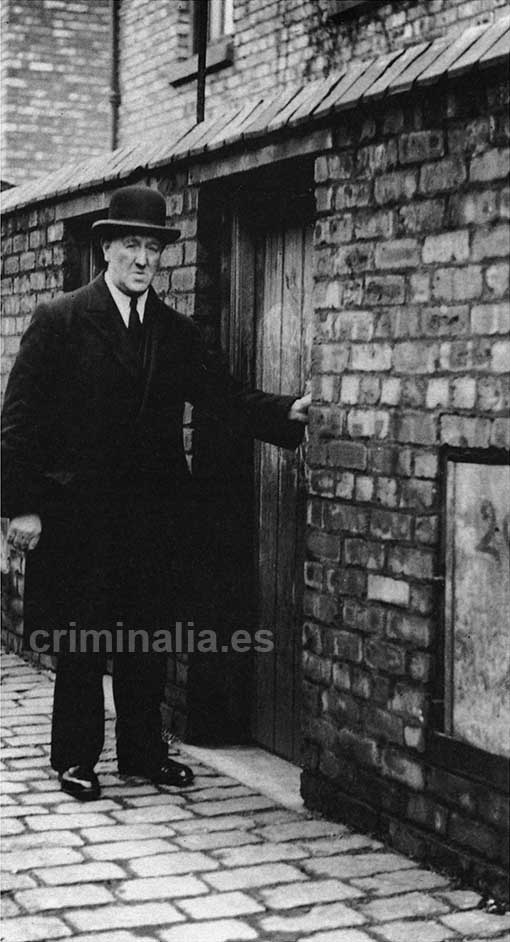
The yard door is bolted. This does not matter, the wall is easily low enough to climb. The window cleaners had done exactly that earlier in the day.
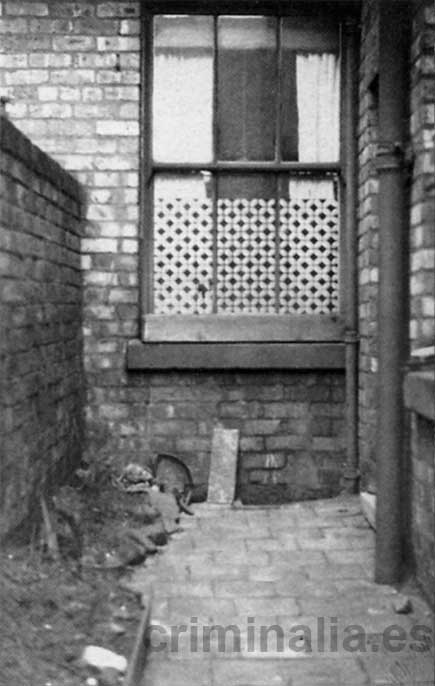
Inside the yard, facing the window which would look into the living kitchen where the cash box would be kept. The door to the scullery is not in view, but is to the right of this window.
The intruders now go about finding a way to enter the house. We know some gangs had access to “skeleton” or “duplicate” keys, and also that they were commonly able to gain unforced entry in any case. The particular gang I mentioned earlier would climb up drainpipes and enter through an unsecured upper story window. If they did this here, they would have entered the window to the upstairs bathroom or middle bedroom where the Wallaces slept.
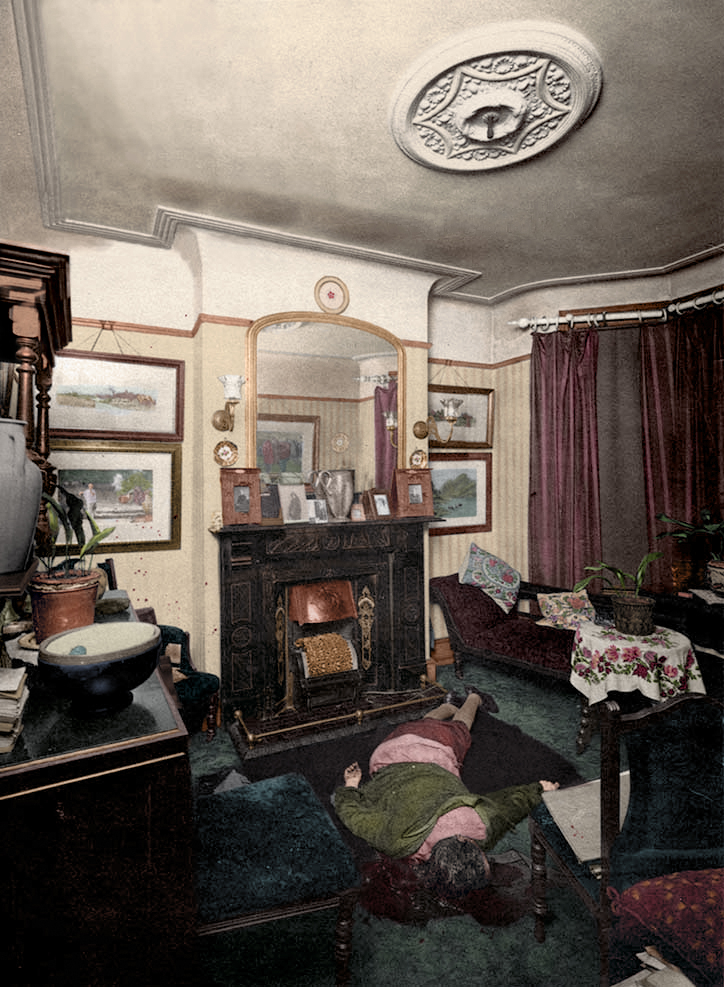
Julia has by now brought the stranger into the parlour. She goes to set it up for him. (Colourized by Laiz Kuczynski).
The intruders are now inside the home, and the stranger with Julia in the parlour. With Julia in the parlour with a guest, she is going to do a few things:
- She gets her box of matches, strikes it in the threshold of the doorway, then moves to light the gas lamps. Wallace claims there were just two jets, and they only lit the one on the right side if they were by themselves.
- She goes to the fireplace, the first match may be burned down by now and thus she discards it.
- Julia gets down at the fireplace and turns on the Sunbeam gas fire using the knob on the right hand side.
- The gas now on, Julia strikes another match and lights the fireplace. It is a possibility she initially leaves the flames on full so it can warm up (and thus warm the room) faster.
- If the fireplace has been lit the stranger distracting her will likely take a seat. They have three chairs and a sofa. I would tend to expect that by instinct the instruder would sit himself closer to the parlour door than Julia, knowing his accomplices are entering the place. It would also provide him a sense of an easier possible escape.
With that said, if we look at the couch/lounger chair on the other side on the room, one of the cushions appears to be wedged down into the gap between the cushion and headrest, which might suggest that someone had sat there to cause that… It would also seem to fit forensically, as it has been suggested that Julia was in the armchair and the attacker in front of the fireplace, with the weapon suggested to be the iron bar which the Wallaces kept to the right hand side of the fire… Therefore if the attacker had got up off of the sofa he could have grabbed the bar as he walked over to Julia and hit her, and the positioning should then all match.
However it could very well be that Florence, William, or one of the detectives had sat there before the photo was taken, or that it had been left like that from a previous day. - If the fire has been on for a little while (which may or may not be necessary for the burning of the jacket and skirt) then it is likely the two were sitting down talking.
- As the two are talking, there is a sound in the home made by the intruder or intruders who have entered without Julia’s knowledge. Julia notices this, as does the man distracting her. He sees or strongly suspects that she has noticed the sound.
- The stranger hits Julia. It may either be the case that as she goes to get up from the fireplace she is hit – OR, she is first hit sitting in the armchair like McFall and my own forensic analysts suggest as a possibility.
[ Depending on how easy it was to see in the room before the lights were put on, it is possible the fire would have been tended to first. ]
I need to work on this series of events some more, consider the above a rough draft.
It may also be the case that two men entered the front door posing as somebody they’re not, which is another very common ploy in this type of crime.
—
If you like this theory and would like to investigate it further, here are the names of youths involved in the gang or with ties to members of the gang:
-
Core Group:
- Joseph Shipley
- Harold Charles Paine
- Fred Birtles
- Robert James Fisher
- David Martin
- Kenneth Frederick Stonehouse
- James Stephen Hall
- John James Hughes
- James Herbert King
- George Overen
- John Melville
- Frederick James Duffey
- Frank Oval Pell
- John Frederick Myers
- Patrick Joseph Garland
Associates:
These are men known to be part of – or associated with – the housebreaking gang which broke into a home at Menlove Gardens South in December 1930, one month before the murder of Julia Wallace.
Without this fact, I don’t think there would be anything to suggest they have anything to do with it, but the use of the Menlove Gardens address “Qualtrough” gave, combined with the fact he seemingly either got lucky or knows West/East would be odd-numbered homes, suggests advanced knowledge of those particular streets. And it seems even more suggestive when it turns out that burglary happened so soon before Julia’s murder.
With that in mind, a few more things begin to fit into place like their usage of drainage grids for disposal, which matches the statement given by John Parkes about where the bar had been hidden.
What we know about this gang is as follows:
- They would sometimes send two men to the doors of houses with a bogus inquiry to see if the residents were home. According to Amy Wallace, she believed that if anyone had called at the home, given the cold weather, Julia would have invited them in.
- They usually struck between the hours of 7 and 12 – Julia was killed between 18:40 and 20:45.
- They never entered a property alone, burglaries would always be carried out by two or more gang members at a time.
- At least three of the members of this gang had committed violent crimes against the elderly. Stonehouse was charged with violent muggings of three elderly women, and accused of a fourth. David Martin and James Hall were also charged.
- At least three of the members of this gang had broken into Menlove Gardens South on the 21st of December, 1930, nearly one month to the very day that Julia Wallace was murdered.
- The gang had been known to shove things down drainage grids, such as stolen jewelry… John Parkes would later tell Radio City that Parry had told him he’d shoved the weapon down a drainage grid on Priory Road.
- Members of the gang would sometimes enter homes armed with weapons including spring-loaded pistols.
- The gang did not force entry into properties, they would climb drainage pipes or find some other means of entry. The man who entered would then open the door to let the rest of the gang in.
- Housebreakers in this gang were in the habit of removing or changing their shoes before entering a property.
In statements the boys detailed how Stonehouse would change into a pair of “goloshes” (a type of rubber boot) before entering homes. We also see from an earlier crime that Paine removed his shoes before attempting to enter the upstairs window of a house.
If the person who had entered the Wallace’s home had been in that habit, it could explain why there were no bloody footprints leading out of the room. - The gang were out on the streets on bail awaiting trial, indulging in what they termed “a final spree” when Julia was murdered.
As we can see,on the days around the 20th of January 1931 when Julia was murdered, the gang – while awaiting trial for the burglaries committed in Allerton – committed at least five more housebreakings in other districts of Liverpool: Wallasey and Southport while indulging in one final crime bender.
I propose that a member or members of this group could have hit one more district during this period: Anfield. Specifically, 29 Wolverton Street.
Of the Anfield housebreaker, author Johnathan Goodman had this to say:
“Between twenty and thirty cases had been reported of houses being entered during the temporary absence of the occupants, and in every case a duplicate or skeleton key had been used. Two houses in Wolverton Street had been visited, the last visit being just before Christmas at No. 19.”
If they are involved, we would have to assume that in this particular case they used a different M.O., since they would typically enter unoccupied homes. With that said, the Wallaces were a very reserved and introverted couple (who apparently took all money in the home out with them whenever they were out together – a fact unlikely to be known by burglars), so it may have felt necessary to use a scheme of some kind as simply knocking about the house at random it would rarely be unoccupied.
If we assume involvement, by looking at the typical M.O. of the gang and its associates, rather than gaining entry via duplicate keys we can see they commonly climb drain pipes and enter through an upstairs window. In crime scene photos, we see there are two drainpipes in the Wallace’s yard:
If an intruder had first entered the upper story, judging by the floor plan of the home they would have entered through the bathroom or middle bedroom window. It may be the case that they had first ransacked the spare “front” bedroom before Julia was killed. Wallace would claim things were not missing, yet I’m not sure this is something we can rely on unless he was intimately familiar with his wife’s possessions. The spare bedroom was rarely entered by Wallace, rather being used for Julia’s things.
We also have evidence he muttered something about Julia’s rings being missing from her fingers on the night of the murder:
“Reaching down, he took hold of her left hand, murmuring something unintelligible about her rings being missing, and then uttered that ‘perhaps she hadn’t had them on’.”
Gannon, John. The Killing of Julia Wallace. Amberley Publishing. Kindle Edition.
She was still wearing her wedding ring and nothing more was made of this statement, so perhaps these other rings really had simply not been worn at the time or found elsewhere in the home.
Though from what we know of the gang’s actions we might expect that any jewelry taken would be left somewhere on the scene or disposed of down drainage grids/in bushes. Notes stolen may also have been left or even incinerated. Statements from the gang shows us that due to a fear of being caught, the youths had done exactly that on numerous occassions (burning random stolen pound notes and randomly keeping other).
As for the “Anfield housebreakings”… Well, although the perpetrators of these crimes were never fingered, the string of Anfield housebreakings stopped immediately following the murder of Julia Wallace – coinciding with the conviction of the aforementioned housebreaking gang. Then again, it’s easy to see why a burglar might be afraid of being caught breaking into a house in the same area where a high profile murder with an apparent burglary motive had taken place.
All newspaper reports relating to this gang: https://www.williamherbertwallace.com/case-files/housebreaker-news-clippings/
Connection to Gordon Parry?: This is where the idea becomes more tenuous as there’s no supporting evidence other than conjecture… It does not mean evidence definitely does not exist, but with how long ago this crime took place and the extent to which the police case files have been pruned, if there is any evidence any witness who could provide a statement will surely be dead, and any files referencing such clues may well be lost.
Still, it is a suggestion made on a purely hypothetical basis…
It was said in the newspaper article that a Joseph Shipley was the mastermind behind the burglary that took place in Menlove Gardens as well as the larger Allerton area and other Liverpool districts.
He lived just a few streets over (half a mile) from Parry’s girlfriend Lily Lloyd at Grenfell Road, Clubmoor, unlike the rest of the gang who all lived in the Wavertree area (south of Gordon near Sefton Park).
A note should also be made that Clubmoor is where Wallace did his insurance rounds. He made some 500+ calls per week. Parry had filled in for Wallace when Wallace was sick a couple of years back so would also have done rounds in Clubmoor. I think I would have to contact the Prudential to ascertain if Wallace had ever collected at the Shipley’s address.

A map showing the homes of Gordon Parry, a known friend of Gordon, Gordon’s girlfriend, and the “mastermind” of the Allerton and Menlove Gardens burglaries Joseph Shipley.
This same Joseph Shipley would die four years later under strange circumstances by falling from a ferry while accompanied by a man named John Payne. It is said he remarked that he suddenly felt dizzy, before falling over the railings.
When his body was found and identified by his parents Mrs. and Mr. Joseph Matthew Shipley, the boy was only identifiable by his clothing.
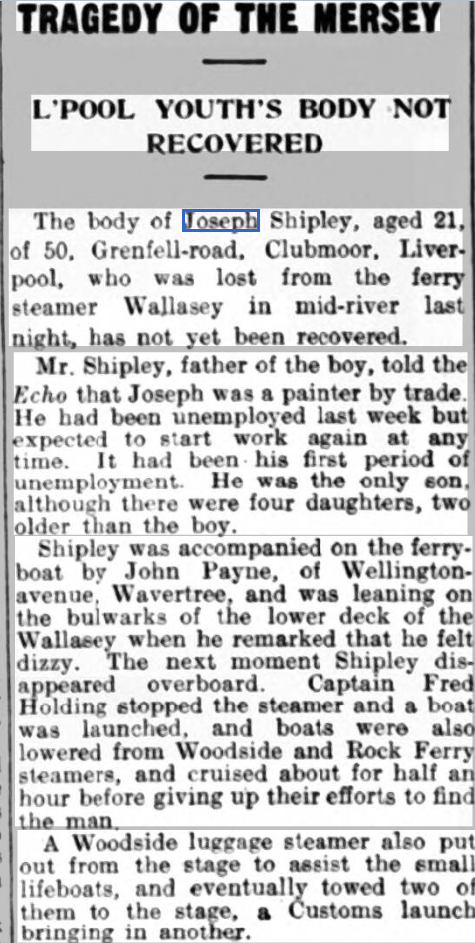
The death of Joseph Shipley, the “ringleader” of the Menlove Gardens/Allerton housebreakers, reported on the 4th February, 1935.
Much like the “well-spoken, well-dressed” Gordon Parry, despite engaging in theft he came from an “eminently respectable family” as one newspaper report put it.
Two other men who seem similar to Parry are Robert Fisher and Fred Birtles. In a newspaper article they were described as “well dressed”. They would not actually do the housebreaking themselves, but would stand outside and collect a share of the takings.
Out of what is known of the members of the gang, Shipley, Fisher, and Birtles seem like the type of person Parry would be most likely to associate with.
To stress again, there is no proveable link at all, but very little is known about the names of the company Gordon Parry kept back in Liverpool… We just know that he was in desperate need of money at the time, not averse to theft (as well as stealing Prudential money while working as an agent he engaged in multiple attempts at motor theft and thieving from telephone kiosks), and thus may well have been acquainted with other crooks living nearby.

